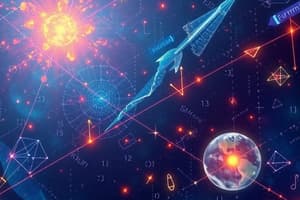Podcast
Questions and Answers
Which statement correctly defines a prime number?
Which statement correctly defines a prime number?
- A number that is the product of two smaller natural numbers.
- A number that can be divided evenly by any natural number.
- A number that is less than one.
- A number that has exactly two distinct positive divisors. (correct)
What is the greatest common divisor (GCD) of 24 and 36?
What is the greatest common divisor (GCD) of 24 and 36?
- 6
- 24
- 12 (correct)
- 18
Which of the following is the least common multiple (LCM) of 4 and 5?
Which of the following is the least common multiple (LCM) of 4 and 5?
- 15
- 20 (correct)
- 10
- 25
Which practice involves carrying out a plan after identifying a problem?
Which practice involves carrying out a plan after identifying a problem?
Which resource would be the most appropriate for plotting a complex function?
Which resource would be the most appropriate for plotting a complex function?
What is the correct order of operations to solve the expression $2 + 3 \times (4 - 1)$?
What is the correct order of operations to solve the expression $2 + 3 \times (4 - 1)$?
Which of the following equations is in standard form?
Which of the following equations is in standard form?
What is the area of a triangle with a base of 10 units and height of 5 units?
What is the area of a triangle with a base of 10 units and height of 5 units?
Which of the following statements correctly describes the tangent function in relation to a right triangle?
Which of the following statements correctly describes the tangent function in relation to a right triangle?
What does the integral represent in calculus?
What does the integral represent in calculus?
Which of the following describes the mean in statistics?
Which of the following describes the mean in statistics?
Flashcards are hidden until you start studying
Study Notes
Key Concepts in Math
1. Basic Arithmetic
- Operations: Addition, Subtraction, Multiplication, Division
- Order of Operations: PEMDAS (Parentheses, Exponents, Multiplication and Division, Addition and Subtraction)
2. Algebra
- Variables: Symbols representing numbers (e.g., x, y)
- Expressions: Combination of variables and constants (e.g., 2x + 3)
- Equations: Mathematical statements that two expressions are equal (e.g., 2x + 3 = 7)
- Functions: Relations between sets that assign each input exactly one output (e.g., f(x) = x²)
3. Geometry
- Shapes and Properties: Circles, triangles, squares, polygons
- Theorems: Pythagorean theorem (a² + b² = c² for right triangles)
- Area and Volume: Formulas for calculating the space within shapes (e.g., Area of a circle = πr², Volume of a cube = a³)
4. Trigonometry
- Basic Functions: Sine, Cosine, Tangent
- Right Triangle Relationships: SOH-CAH-TOA (Sine = Opposite/Hypotenuse, Cosine = Adjacent/Hypotenuse, Tangent = Opposite/Adjacent)
5. Calculus
- Limits: Understanding the behavior of functions as they approach a specific point
- Derivatives: Measure of how a function changes as its input changes
- Integrals: Area under the curve of a function; accumulation of quantities
6. Statistics
- Descriptive Statistics: Mean, median, mode, range
- Probability: Likelihood of events occurring; basic rules (e.g., addition and multiplication rules)
- Distributions: Normal distribution, binomial distribution, etc.
7. Number Theory
- Prime Numbers: Natural numbers greater than 1 that have no divisors other than 1 and themselves
- Greatest Common Divisor (GCD): Largest number that divides two or more numbers without leaving a remainder
- Least Common Multiple (LCM): Smallest multiple common to two or more numbers
Mathematical Practices
- Problem-Solving: Identify the problem, devise a plan, carry out the plan, review/extend
- Critical Thinking: Analyze and evaluate arguments and claims
- Logical Reasoning: Use deductive and inductive reasoning to draw conclusions
Tools & Resources
- Calculators: Used for complex calculations
- Graphing Software: For plotting functions and analyzing data
- Online Platforms: Websites and apps for practicing math problems and concepts
Key Concepts in Math
Basic Arithmetic
- Operations encompass addition, subtraction, multiplication, and division.
- The order of operations is essential for solving expressions accurately, represented by the acronym PEMDAS.
Algebra
- Variables are symbols used to represent unknown numbers, such as x and y.
- Expressions combine variables and constants, for example, 2x + 3.
- Equations define a relationship where two expressions are equal, such as 2x + 3 = 7.
- Functions link sets of inputs to unique outputs, exemplified by f(x) = x².
Geometry
- Fundamental shapes include circles, triangles, squares, and polygons, each with unique properties.
- The Pythagorean theorem describes the relationship between the lengths of sides in right triangles (a² + b² = c²).
- Area and volume formulas help calculate space within shapes, e.g., area of a circle = πr² and volume of a cube = a³.
Trigonometry
- Basic functions in trigonometry are sine, cosine, and tangent, interconnected through right triangle relationships.
- SOH-CAH-TOA mnemonic aids in remembering ratios: Sine = Opposite/Hypotenuse, Cosine = Adjacent/Hypotenuse, Tangent = Opposite/Adjacent.
Calculus
- Limits illustrate the behavior of functions as they near a specific point.
- Derivatives indicate how a function's output changes in response to changes in input.
- Integrals represent the area under a function's curve, signifying accumulated quantities.
Statistics
- Descriptive statistics summarize data using measures like mean, median, mode, and range.
- Probability assesses the likelihood of events, governed by addition and multiplication rules.
- Distributions categorize data types such as normal and binomial distributions.
Number Theory
- Prime numbers are defined as natural numbers greater than 1, with no divisors other than 1 and themselves.
- The Greatest Common Divisor (GCD) is the largest number that evenly divides two or more numbers.
- The Least Common Multiple (LCM) is the smallest multiple shared by two or more numbers.
Mathematical Practices
- Problem-solving involves identifying the challenge, planning a solution, executing it, and reviewing the outcome.
- Critical thinking requires the analysis and evaluation of arguments and claims.
- Logical reasoning employs deductive and inductive methods to reach conclusions.
Tools & Resources
- Calculators are essential for performing complex mathematical calculations efficiently.
- Graphing software assists in visualizing functions and data analysis.
- Online platforms provide additional practice and resources for mastering math concepts and problems.
Studying That Suits You
Use AI to generate personalized quizzes and flashcards to suit your learning preferences.




